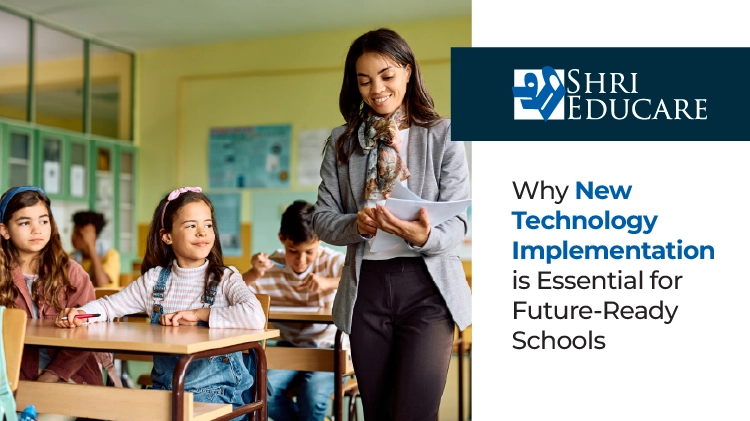Step into any modern classroom today, and you’ll notice something striking—it looks nothing like the ones we sat in just a decade ago. The world outside is moving fast, and education can’t afford to lag behind. If schools want to truly prepare students for what lies ahead, new technology implementation isn’t just a luxury—it’s a non-negotiable necessity.
But let’s get one thing straight. This isn’t about replacing books with tablets or teachers with AI tutors. It’s about bridging the gap between traditional education and the digital world students are already living in. Done right, technology doesn’t just make learning more efficient; it makes it more engaging, more personalized, and infinitely more relevant.
The Problem with Sticking to the Old Playbook
Remember those days of scribbling down notes from the blackboard, flipping through bulky textbooks, and relying solely on a teacher’s lecture? It worked back then, but times have changed. Information isn’t confined to books anymore; new technology implementation is everywhere—on the internet, in podcasts, through interactive simulations.
Here’s the catch: students today are wired differently. Their minds are conditioned to process information visually, interactively, and at a rapid pace. The old-school, one-size-fits-all approach? It’s losing its grip. Studies show that students retain 60% more information when they engage in interactive, tech-driven learning compared to passive listening.
If we keep teaching kids the way we were taught, we aren’t preparing them for their future—we’re preparing them for our past.
Technology as the Ultimate Engagement Booster
Keeping students engaged is half the battle. Between social media, video games, and constant digital stimulation, traditional teaching methods can feel… well, dull. But new technology implementation can change that.
Imagine a history class where students step into ancient Rome through virtual reality, rather than memorizing dull dates from a textbook. Or a physics lesson where they can experiment with forces and motion through an interactive simulation, rather than just reading about it.
Technology makes learning feel like an experience rather than a chore. And when students are engaged, learning isn’t something they “have to do”—it’s something they want to do.
One Size Does Not Fit All
Every student learns differently. Some grasp concepts quickly, while others need more time. Some are visual learners, some absorb better through hands-on practice. The problem? Traditional classrooms have always catered to the average, leaving both struggling and gifted students underserved.
New technology implementation fixes this.
AI-driven platforms adapt to individual learning speeds, providing extra support where needed and acceleration where possible. A student struggling with algebra? The system identifies weak spots and tailors extra practice. Another student breezing through chemistry? The platform offers advanced challenges to keep them engaged.
This isn’t the future—it’s already happening. And it’s revolutionizing how we think about education.
Learning Beyond the Classroom
Old-school learning was confined to classroom walls, limited by geography and resources. Not anymore. New technology implementation has made it possible for students to access world-class education from anywhere.
- A student in a rural town can take a coding course from an Ivy League professor.
- An aspiring scientist can conduct virtual lab experiments without expensive equipment.
- A language learner can practice speaking with AI-driven tutors, eliminating the need for physical immersion.
The world has become one giant classroom, and technology is the key that unlocks the door.
Prepping Students for the Real World
Gone are the days when group projects meant messy handwritten notes, late-night library meetups, and frantic last-minute scrambling. With new technology implementation like Google Classroom, Microsoft Teams, and interactive project management software, students today can collaborate seamlessly—anytime, anywhere.
This isn’t just about making schoolwork easier. It’s preparing students for the modern workplace, where remote teams, digital communication, and cloud-based collaboration are the norm. By integrating these tools early, schools aren’t just teaching students what to learn—they’re teaching them how to work effectively in a digitally connected world.
Data-Driven Teaching
Teachers have always been the backbone of education. But they’re also human. Keeping track of every student’s progress, struggles, and strengths manually is overwhelming. This is where technology steps in, not to replace teachers, but to empower them.
New technology implementation analytics can identify patterns in student performance, flagging areas where intervention is needed. Instead of waiting for a student to fail an exam before realizing they need help, teachers get real-time insights to step in before it’s too late.
Think of it as a GPS for education—constantly guiding, adjusting, and ensuring no student is left behind.
Addressing the Challenges of Tech Integration
Of course, new technology implementation in education isn’t without hurdles. Budget constraints, resistance to change, lack of training—these are real concerns. But the solution isn’t to avoid it altogether; it’s to approach it strategically.
- Invest in teacher training—A tool is only as good as the person using it. Empower teachers to leverage tech effectively.
- Prioritize accessibility—Ensure students from all backgrounds have the necessary devices and internet access.
- Adopt a phased approach—Instead of an overnight transformation, schools can start small—introducing smart classrooms, then AI-driven learning, then VR-based education.
The goal isn’t tech for the sake of tech. It’s about using technology to enhance what already works, fix what doesn’t, and create something better for the future.
The Future of Education is Digital
The question is no longer “Should we implement technology in education?” The real question is while school opening in India is “How fast can we do it effectively?”
Education today isn’t about cramming information into young minds. It’s about teaching them to think, to create, to problem-solve. And to do that, schools must reflect the world they’re preparing students for—a world driven by technology.
At Shri Educare, we’re committed to making this transition seamless. Our mission is to help schools know new technology implementation in a way that enhances learning, empowers teachers, and prepares students for the future—without losing the human touch that makes education so powerful.
Because when technology meets education, the possibilities are endless.



